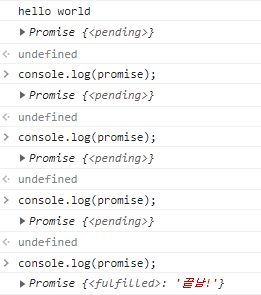
콜백 함수
const 버튼 = document.querySelector('.button');
버튼.addEventListener('click', function(){});
// 버튼.addEventListener('click', '다른 곳에서 짠 함수이름'); // ex('click', helloworld100)
// 버튼.addEventListener('click', ()=>{});콜백 함수는 나중에 실행할 함수이다.
.으로 들어가서 사용하는 것은 메소드라고 부르고, function은 함수라고 부른다.
function 함수하나(출력){
console.log('hello');
출력('world');
}
let hyunho = console.log;
hyunho('hello world');콜백함수이기에 위와같이 사용할 수 있다. (이렇게 사용하지는 말자. 닌자가 되기 싫다면..)
- *콜백 지옥
a조건을 만족할 경우 b조건을 하는데, b조건을 만족하는경우 c를하고..
이런 경우에 위와 같이 코드를 설계한다면, 깊이가 계속 깊어진다. 이것을 콜백 지옥이라고 부른다.
Promise
이러한 콜백 지옥을 탈출할 수 있게 만들어주는 것이 promise이다. promise는 '언제 내가 널(콜백함수) 다시 불러줄지 모르겠지만, 언젠가 널 다시 불러주겠다' 와 같이 약속하겠다는 뜻이다. 그리고 promise는 성공과 실패만 한다.
(2022년에는 대부분) (promise를 여러개 실행할 수 있는) Promise.all보다는 allSettled(실패한 것만 추려내는 기능이 있음)를사용할 것으로 보인다.
// 모던자바스크립트 예제
let promise = new Promise(function(resolve, reject) {
// 프라미스가 만들어지면 executor 함수는 자동으로 실행됩니다.
// 2초 뒤에 일이 성공적으로 끝났다는 신호가 전달되면서 result는 'done'이 됩니다.
setTimeout(() => resolve("끝남!"), 2000);
});
console.log('hello world');
console.log(promise);
2초뒤에 resolve("끝남!")이 실행된다. 그래서 console.log(promise);를 2초가 되기 전에 찍어보면 pending이 출력된다.
- 대기(pending): 이행하거나 거부되지 않은 초기 상태.
- 이행(fulfilled): 연산이 성공적으로 완료됨.
- 거부(rejected): 연산이 실패함.
그리고 위의 예제에서 비동기의 특징도 살펴볼 수 있다. 우리가 생각하기에는 Promise가 생성이 끝나면, hello world가 찍혀야하는데 그 전에 먼저 찍혀버린다.
new Promise((resolve, reject) => {...code...})
.then(...code...)
.then(...code...)
.finally(...code...)
.catch(...code...); // <-- .catch에서 에러 객체를 다룰 수 있음이제 Promise는 이런식으로 사용 된다.
- then
// 모던자바스크립트 예제
let p = new Promise(function(resolve, reject) {
setTimeout(() => resolve(1), 20000);
});
console.log('hello world');
let p2 = p.then(function(result) {
console.log(result); // 1
return result * 2;
});
console.log('hello world2');
let p3 = p2.then(function(result) {
console.log(result); // 2
return result * 2;
});
console.log('hello world3');
let p4 = p3.then(function(result) {
console.log(result); // 4
return result * 2;
});'hello world', 'hello world2', 'hello world3'이 먼저 실행된다. 2초 후에는 resolve(1)가 실행되므로, then으로가서 1이 찍히고, 계산후에 다시 then으로가서 2가찍힌다. 그리고 계산을하고 다시 then으로가서 4가 찍히고 마지막 계산을하고 끝이난다.
- catch
// 모던자바스크립트 예제 (살짝 수정)
new Promise(function(resolve, reject) {
setTimeout(() => reject('error'), 1000); // (*)
}).then(function(result) {
alert(result + ' : 잘 수행!'); // 1
return result + 'one';
}).catch(function(result) {
alert(result + ' : 애러 발생!');
return result + 'two';
}).then(function(result) {
alert(result + ' : 잘 수행!'); // 4
return result + 'three';
});catch에 errorone이 들어가야 맞는 동작이라고 생각할 수 있다. 하지만 에러 발생이 나타났다.
then은 성공적으로 실행되고 잡으므로 resolve 후에 잡는것이다.
reject는 catch가 잡는다.
문제
// 문제 : 1차 접종자의 퍼센트를 가지고 오세요!
fetch('https://raw.githubusercontent.com/paullabkorea/coronaVaccinationStatus/main/data/data.json')
.then(function(response) {
return response.json();
})
.then(function(json) {
console.log(json);
return json
})크롬 about:blank에서 위 코드를 넣어보자.

데이터들이 나타나는것을 볼 수 있다.
이제 여기서 1차 접종자의 퍼센트를 구해보자.
.then(function(json) {
console.log(json.filter(s => s['시·도별(1)'] === '전국'));
return
})이 코드를 넣으면 동작한다.
마무리
// 정리 전
loadScript('1.js', function(error, script) {
if (error) {
handleError(error);
} else {
// ...
loadScript('2.js', function(error, script) {
if (error) {
handleError(error);
} else {
// ...
loadScript('3.js', function(error, script) {
if (error) {
handleError(error);
} else {
// 모든 스크립트가 로딩된 후, 실행 흐름이 이어집니다. (*)
}
});
}
})
}
});
// 정리 후
loadScript("/article/promise-chaining/one.js")
.then(script => loadScript("/article/promise-chaining/two.js"))
.then(script => loadScript("/article/promise-chaining/three.js"))
.then(script => {
// 스크립트를 정상적으로 불러왔기 때문에 스크립트 내의 함수를 호출할 수 있습니다.
one();
two();
three();
});Promise를 사용해서 콜백지옥이 어느 정도 극복된 것으로 보인다.
